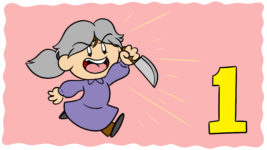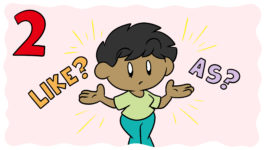In fiction, any kind of relationship is possible. There are stories of forbidden love, undying vengeance, infernal temptation, and life-affirming rivalry. Each studies part of the human condition, finding truth and insight in the way we interact with those around us, but what about when people just… like each other?
It’s something we encounter every day, but that doesn’t make it easy to write, and perhaps because of its ubiquity, it can be hard to truly capture on the page. That’s why, in today’s article, we’ll be tackling tips and tricks for writing characters who actually like each other.
Accentuate the positives
One of the problems of writing characters who actually like each other is that much of the value of friendship goes unspoken in day-to-day life. Friends don’t spend all their time explaining why they like each other or unpicking the positive qualities of their relationship.
If, then, you simply transcribe two people who like each other, what you’ll end up with is a list of banalities punctuated by references, jokes, and comments that derive their value from unspoken assumptions and shared history – valuable interactions, yes, but not the kind of thing that’s compelling to a reader.
So far, so banal, but the problem arises when you throw in the ribbing that’s natural to many friendships. Throw in some friendly insults and, while the reader is smart enough to understand that this can be part of a friendship, they are far less likely to get a sense of joy out of the interaction; the characters are technically friends, but they only ‘like’ each other because the author says so.
This problem is accentuated by the fact that put-downs are funnier and easier to write than compelling moments of affection, often leading to stories where characters spend almost all their time together swapping barbs and rolling their eyes. Again, readers are used to this, they understand what’s being done, but they still don’t come away from the work in question with the impression that these people share sincere affection.
There are several ways to address this, and we’ll touch on more shortly, but the most obvious antidote is to include moments where the characters a) experience explicit affection and b) make it clear what they’re getting from this relationship.
In the extract below, Louisa May Alcott creates a moment of sincere friend-to-friend support, making sure to specifically point out that it’s not just the words that matter, but who they came from:
“Well, I’ve left two stories with a newspaper man, and he’s to give his answer next week,” whispered Jo, in her confidant’s ear.
“Hurrah for Miss March, the celebrated American authoress!” cried Laurie, throwing his hat and catching it again, to the great delight of two ducks, four cats, five hens, and half a dozen Irish children; for they were out of the city now.
“Hush! It won’t come to anything, I dare say; but I couldn’t rest till I had tried, and I said nothing about it, because I didn’t want any one else to be disappointed.”
“It won’t fail! Why, Jo, your stories are works of Shakespeare compared to half the rubbish that’s published every day. Won’t it be fun to see them in print; and shan’t we feel proud of our authoress?”
Jo’s eyes sparkled, for it’s always pleasant to be believed in; and a friend’s praise is always sweeter than a dozen newspaper puffs.
– Little Women, Louisa May Alcott
If this sounds simple, it is, but a lot of writers (in fact, a lot of creators) only include these moments as the pay-offs to more contentious interactions; the heartfelt bow on an otherwise snarky, combative relationship. This is an easy way to recontextualize sniping – the nice moment means that the mean stuff was all in good fun – but it doesn’t do much for creating a sense of affection. You’re buying back the negativity, but you’re not really creating any positivity.
To leave the reader with the sense that this is an affectionate relationship between people who like each other, find moments to accentuate the positive as part of the characters’ normal interactions. State what they enjoy and value in each other and, if opportunities to do so aren’t appearing naturally, create them.
An easy place to start is by having characters enjoy things that are there for the reader. Everything in a story happens for the reader, and this can mean character reactions get overlooked. If a character does something kind, it’s easy to ignore the other characters’ reactions because it’s the reader’s opinion that really counts, or if a funny character makes a joke, it’s common for the other characters to barely react because the joke is actually aimed at the reader.
These moments don’t have to be huge to be significant. In the extract below, Sax Raker expresses mock distress that his companion, Doctor Robert Watcham, has changed how he takes his tea:
“I must say, I am distressed by this change in habit, Watcham. Your stoic adherence to routine made you quite my rock of stability.”
“It’s an extra lump of sugar, Sax.”
“Do not seek to lessen the enormity of it. It juts out of the perfect still pond of your life like the inappropriate arse of a dead walrus.”
“Ha!”
– Warren Ellis, Aetheric Mechanics
By writing the briefest reaction, the author makes it clear that Watcham appreciates his friend’s wit. Added to the fact that Watcham has been relatively dour up to this point in the story, it signals to the reader that these are people who sincerely enjoy each other’s company.
Subvert (some) conflict
Real friendships have conflict large and small, and we recently discussed why conflict is the lifeblood of story, so here I’m not suggesting that everything should be placid compliments and chummy in-jokes. Instead, this piece of advice is about deliberately subverting conflict to clarify the more affectionate aspects of a relationship.
For example, the opening chapter of Dashiell Hammett’s The Thin Man introduces the protagonist, Nick Charles, being approached by an attractive young woman. It’s the clichéd way to go that when his wife, Nora, arrives and finds them chatting, she’d react jealously, but it doesn’t happen. She ribs him a little in good humor, bringing up another occasion of clear flirtation, but the chapter ends without either of them needing to resolve any true tension. Nick and Nora love each other, they like each other, and so the conflict that would arise between two less secure individuals never forms:
We found a table. Nora said: “She’s pretty.”
“If you like them like that.”
She grinned at me. “You got types?”
“Only you, darling – lanky brunettes with wicked jaws.”
“And how about the red-head you wandered off with at the Quinns’ last night?”
“That’s silly,” I said. “She just wanted to show me some French etchings.”
– Dashiell Hammett, The Thin Man
When Nora tries to persuade Nick to take the woman’s case and he refuses, when they’re threatened at gunpoint, when she ends up disappointed by how events turn out, the couple never resort to argument. First and foremost, they’re committed to enjoying each other’s company, and every time the reader senses a moment that would naturally result in conflict and then sees Nick and Nora approach it with grace, good humor, and wit, they take away the sense that these people aren’t just passively avoiding conflict, they’re actively choosing camaraderie instead.
That’s not to say that conflict is inherently opposed to a sense of genuine affection, but if you can cue the reader to expect conflict and then either subvert it entirely or deal with it in another way, the affection will feel even more significant.
For example, if a character takes the time to deal with their jealousy over a promotion before congratulating a friend, allowing them to be sincere where the reader assumed they’d be hiding their true feelings, you get a moment that’s even more rewarding than if the conflict had never been teased.
Create unspoken understanding
So far, depicting a positive relationship has been about demonstrating affection – making sure that the good feelings are expressed and the bad feelings are processed in surprising ways – but even here there are times when less is more.
Sometimes, moments of unspoken affection hit harder than direct expression (although a great fictional friendship has both.) One way to depict this kind of affection is to cut the middle out of communication.
In a discussion between two regular characters, one character will make a statement, then the other will give the reasons they agree or disagree, then the first character may try to talk them round. This is a useful narrative device because it’s a performance for the reader, who has the opportunity to learn what each character believes and understands about the circumstances in question.
However, when two characters really know each other, it can be more engaging if this process is truncated. For example, the first character already knows the other will disagree, so they pre-empt their reasoning in the way they phrase their opening comment.
In the extract below, the demon Crowley is attempting to talk the angel Aziraphale into helping him prevent the Apocalypse – an event that both their ‘employers’ want to see play out but which the characters, having grown accustomed to life on Earth, would rather avoid. Having spent millennia in each other’s company, the two have a strong bond, and so rather than start with generic points, Crowley tailors his argument, both accepting Aziraphale’s premise that Heaven will win out and emphasizing those elements of Earth’s culture that the angel most values:
‘We’ll win, of course,’ he said.
‘You don’t want that,’ said the demon.
‘Why not, pray?’
‘Listen,’ said Crowley desperately, ‘how many musicians do you think your side have got, eh? First grade, I mean.’
Aziraphale looked taken aback.
‘Well, I should think—’ he began.
‘Two,’ said Crowley. ‘Elgar and Liszt. That’s all. We’ve got the rest. Beethoven, Brahms, all the Bachs, Mozart, the lot. Can you imagine eternity with Elgar?’
Aziraphale shut his eyes. ‘All too easily,’ he groaned.
‘That’s it, then,’ said Crowley, a gleam of triumph. He knew Aziraphale’s weak spot all right. ‘No more compact discs. No more Albert Hall. No more Proms. No more Glyndbourne. Just celestial harmonies all day long.’
– Terry Pratchett and Neil Gaiman, Good Omens
Here, Crowley is able to accurately predict Aziraphale’s eventual opinion, ‘You don’t want that,’ before the angel even knows he has it, then to give him the exact examples that will win him over. Of course, there are ways to write this that feel aggressive – telling someone how they feel is often unwelcome – but one character having a perfect ‘read’ on another is a good way to signal intimacy. This can be big (the reasons they’re on board for saving the world) or small (knowing which snacks they’ll want for movie night), but by using insight to skip ahead in a conversation, you can signal to the reader that this relationship differs from the others you’re depicting.
An offshoot of this type of intimacy is having characters influence each other even outside immediate interaction. If Character A knows exactly how Character B thinks, it stands to reason that there will be situations where that outlook influences them even when Character B isn’t present. For Aziraphale and Crowley, this takes the form of moral flexibility as they go about their professional duties:
It was the sort of sensible arrangement that many isolated agents, working in awkward conditions a long way from their superiors, reach with their opposite number when they realize that they have more in common with their immediate opponents than their remote allies.
… it had seemed even natural that they should, as it were, hold the fort for one another whenever common sense dictated. Both were of angel stock, after all. If one was going to Hull for a quick temptation, it made sense to nip across the city and carry out a standard brief moment of divine ecstasy. It’d get done anyway, and being sensible about it gave everyone more free time and cut down on expenses.
– Terry Pratchett and Neil Gaiman, Good Omens
This type of influence might be expressed in terms of moral outlook, political opinion, cultural tastes, or any of the other ways we think and feel, but giving Character A a little B and Character B a little A helps to show that the two share a significant bond.
As with showing what’s good about the friendship, this can work in very subtle ways, but it’s also useful to explicitly point out how your characters have changed each other – affection and intimacy may go unspoken between your characters, but don’t keep them a secret from your reader.
Stay busy
One of the happy benefits of depicting characters who really like each other is that it tends to create engaging scenes. Watching people enjoy each other’s company is, in and of itself, enjoyable, and while that’s great for your book, it’s also a reason to be cautious.
One of the pitfalls of good character relationships is that their bond can slow down scenes. Many authors fall too deeply in love with a friendship or romantic pairing and devote page after page to witty banter and heartfelt moments. Those pages are fun, they’re enjoyable in the moment, but they serve to slow the overall momentum of the story, and everything else suffers.
The final tip for depicting affectionate characters is therefore to keep them busy. Have them performing a task, discovering or sharing information briefly, or working their way out of a challenge. It can be counter-intuitive to avoid the characters you want to watch, but enjoying characters who like each other isn’t the main show, it’s a new ingredient. By this, I mean that it’s better to take the expositional scene where the detective lays out the clues, or the unavoidable section where the characters search for information that will progress the story, and turn that necessary boredom into a scene crackling with chemistry.
You now have characters who the reader wants to be around, so let them do some of the heavy lifting. If one character is going to be elated that the other is pursuing a writing career, then make that scene the one in which the reader learns that information. Whenever your best-of-friends characters get together, ask what else that scene is achieving. If nothing, cut the scene or give them a job. It’s hard to fight the urge to just focus on a scene you enjoy writing until it has naturally run its course, but this is what editors mean when we advise ‘kill your darlings.’
Let’s keep it friendly
Writing characters who are friends because you say they’re friends is easy, but creating a sense of genuine affection takes both insight and effort. Happily, when you’re successful, you end up with characters that readers love to spend time with – Nick and Nora only appear in one book (Hammett’s last published novel), but their chemistry is so palpable (and was so faithfully realized on screen) that the film adaptation of The Thin Man spawned five sequels, just so audiences could keep visiting Nick and Nora. Likewise, Crowley and Aziraphale are the literary nerd’s ship of choice, and Little Women has never left the spotlight of mainstream appeal.
Conflict may drive stories, but real affection offers its own benefits. Let me know your tips for depicting true friendship in the comments, and check out How To Give Your Hero Some Personality and How Do You Write A Great Tsundere Character? for some related ideas on writing great characters, as well as 6 Secrets To Writing A Thrilling Argument for when those friends hit choppy waters.





